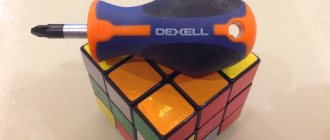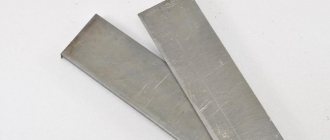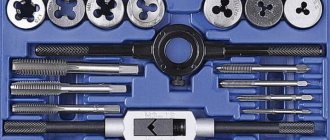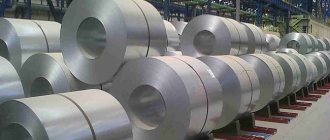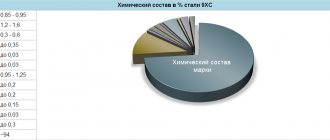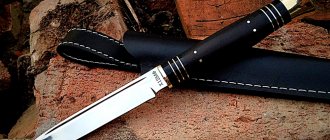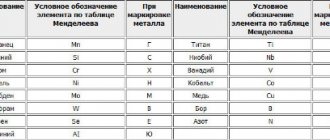CHEMICAL COMPOSITION OF TOOL STEEL X12MF
- Chromium (Cr). Content 11 – 12.5%. Chrome increases wear resistance and cutting properties. Makes metal resistant to corrosion.
- Carbon (C). Content 1.45 – 1.65%. Gives steel hardness and durability, increases the resistance of the alloy during heat treatment, and also makes it more durable.
- Molybdenum (Mo) - 0.40 - 0.60%, Vanadium (V) - 0.15 - 0.30%. Silicon (Si) - 0.10 0.40%. Steel is hardened in deep layers thanks to this element.
- Manganese (Mn) – 0.15 – 0.45%. Thanks to it, the alloy is less deformed during hardening.
- Nickel (Ni) - no more than 0.35% and Copper (Cu) - no more than 0.30%. The content of elements in the composition of steel prevents carbon from reacting with other components and improves ductility, and also eliminates brittleness during tempering.
- Phosphorus (P) allows metal to be cast smoothly during the annealing stage and improves ductility. Its content for high-quality steel should be no more than 0.030%.
Steel grade X12
| Brand: X12 Class: Die tool steel Type of delivery: long products, including shaped steel GOST 5950-2000, GOST 2590-2006, GOST 2591-2006. Calibrated rod GOST 5950-2000, GOST 7417-75, GOST 8559-75, GOST 8560-78. Polished rod and silver steel GOST 5950-2000, GOST 14955-77. Strip GOST 4405-75. Forgings and forged blanks GOST 5950-2000, GOST 1133-71, GOST 7831-78. Industrial use: cold dies with high abrasion resistance, not subject to strong impacts and shocks; drawing boards, eyes for calibrating bar metal for thread rolling, bending and forming dies, complex sections of body dies, dies and punches of cutting and perforating dies, stamping of the active part of electrical machines, etc. |
| Chemical composition in % of X12 steel | ||
| C | 2 — 2,2 | |
| Si | 0,1 — 0,4 | |
| Mn | 0,15 — 0,45 | |
| Ni | up to 0.35 | |
| S | up to 0.03 | |
| P | up to 0.03 | |
| Cr | 11,5 — 13 | |
| Mo | up to 0.2 | |
| W | up to 0.2 | |
| V | up to 0.15 | |
| Ti | up to 0.03 | |
| Cu | up to 0.3 | |
| Fe | ~83 | |
| Additional information and properties |
| Critical point temperature: Ac1 = 810, Ac3(Acm) = 835, Ar3(Arcm) = 770, Ar1 = 755, Mn = 180 |
| Hardness of X12 steel after heat treatment | |||
| Delivery condition, heat treatment modes | HRC∂ (HB) | ||
| Annealed or highly tempered rods and strips. Hardening 970 °C, oil. Tempering 180 °C Isothermal annealing 830-850 °C, cooling at a rate of 40 degrees/h to 720-740 °C, holding for 3-4 hours, cooling at a rate of 50 degrees/h to 550 °C, air. Heating 650-700 °C. Quenching 950-980 °C, oil Tempering: 180-200 °C, 1.5 hours air (final heat treatment mode) 320-350 °C, 1.5 hours air (final heat treatment mode) | To (255) St. 62 (255) 61-63 58-59 | ||
| Impact strength and hardness of X12 steel depending on tempering temperature | ||
| Temperature, °C | KCU (J/cm2) | HRC∂ |
| Isothermal hardening with 1000 °C and holding for 40 minutes at 250-350 ° C. Tempering with holding for 1 hour | ||
| 150 200 250 | 22 22 23 | 64 63 61 |
| Isothermal hardening from 1050 °C with exposure for 40 minutes at 250-350 °C. Holiday with holding time 1 hour | ||
| 150 200 250 | 32 33 34 | 62 60 58 |
| Hardening 960-980 °C, oil. Tempering holding time 1.5 hours | ||
| 200 300 400 500 | 10 15 34 — | 64 62 59 56 |
Electroslag surfacing of X12 steel: electroslag surfacing is used if the surface area of the part to be surfaced is large enough. It is performed both in the lower and vertical positions. For high-chromium ledeburite steels of type X12, the main alloying elements are carbon (1.2-2.3%) and chromium (11.5-13.5%). Some of this type of steel is alloyed with minor additions of tungsten, molybdenum, nitrogen, nickel, vanadium and titanium. The main alloying elements give steels high hardness, wear resistance, deep hardenability and low deformability during hardening. After annealing, they are satisfactorily processed by the cutter.
Tools with a deposited layer of steel type X12 are designed for processing particularly hard materials. For surfacing, mainly flux-cored electrode wires with a diameter of 2.8-3 mm and AN-26 flux are used. The chemical composition of cored wires is given in the table below. These wires provide the deposited metal with a standard composition in normal modes of electroslag surfacing (Ic per wire 250 - 500 A, Uc = 30-35 V). The best results were obtained with alternating current.
| Wire | Composition, % (0.3% 51, 0.4% MP) | |||
| C | Cr | V | Other elements | |
| PP-H 12VF/ESh | 2.3 — 2.4 | 16 — 17 | 0.3 | 1.2W |
| PP-H 12M/ESh | 2 | 15.5 | 0.3 | 0.7 Mo |
| PP-H 12F1/ESh | 2 | 16 | 1.2 | — |
| PP-Kh 12N4F/ESh | 2.3 — 2.5 | 16 | 0.3 | 4 Ni |
| PP-H 12/ESh | 2.3 — 2.4 | 16 — 17 | — | — |
Workpieces weighing more than 25 kg should be heated before surfacing, and after surfacing, annealed at a temperature of 700 ° C for 1-2 hours with slow cooling. This will avoid the appearance of cold cracks after surfacing.
For subsequent mechanical processing, the deposited product is annealed according to the following regime: heating to 800-870° C, holding for 1 - 4 hours, slow cooling to 700° C, cooling in air; the total cooling time must be at least 10 hours. After mechanical processing, the product is subjected to hardening and tempering. Hardening modes are selected depending on the nature of the operation.
ESSENCE OF THE STEEL PRODUCTION PROCESS
Die tool steel is difficult to machine. It is necessary to strictly follow the quenching and tempering technology in order to obtain a high-quality alloy.
The metal is smelted in electric furnaces, open-hearth furnaces and oxygen converters, strictly maintaining temperatures up to 950 0C. If the temperature regime is violated, the steel will become brittle when cooled and will crumble during forging. Forging temperature 850 – 1140 0C.
The crystal lattice becomes stable after quenching and annealing. Hot metal releases internal tension and becomes solid.
X12MF steel is hardened and tempered several times to make it as strong as possible. The steel sheet is then hammered to give the alloy stability. The endurance of steel is 650 – 800 MPa.
The sheets are fired in a vacuum furnace and sent to metallurgical plants in the form of rolled products, wheels, ground and calibrated rods, strips, sheets and plates, blanks, slabs, forgings and forged blanks.
X12MF steel is cast exclusively in production foundries.
Steel grade X12MF for knives: pros and cons
Like any other steel, the X12MF grade has its advantages and disadvantages.
Its advantages are:
- high cutting properties;
- reasonable price;
- long-term sharpening retention;
- increased blade strength.
Experts will confirm that steel knives have one peculiarity: a maximally sharpened edge does not hold an edge well and quickly becomes dull. This cannot be said about the X12MF knives. The optimal percentage of carbon provides special resistance to wear, so a product with this marking will remain sharp for a very long time. In camping conditions, you can safely cut down bushes with a knife for a long time, and the blade will still retain good cutting abilities. At the same time, if you still intend to improve the sharpness, then using a stone with diamond chips will speed up the sharpening time.
Steel has its drawbacks. In particular, you should not use a knife made of steel of this marking to cut hard objects (for example, bones) - there is a risk of chips on the blade. Despite a certain level of elasticity, try not to test the knife for bending. The reason for all this is some fragility of the metal.
STEEL X12MF CHARACTERISTICS, APPLICATION
Alloy steel is indispensable in metallurgy, mechanical engineering, the manufacture of cold-formed tools, and in the production of electrical equipment.
The aviation, motorcycle, and shipbuilding industries actively use the X12MF alloy in the production of parts.
Gears, body and molding dies, hole-punching dies, stampings of electrical machines, rolling dies, dies, dies and punches of cutting dies with complex shapes are made from it. The dies remain sharp even after more than 5,000 blanks have been cut from them.
Stamped tool alloy is considered the best in the production of edged weapons, knives for home use, as well as equipment for hunters and tourists.
X12MF knife steel: pros and cons
Knives made from this steel are unrivaled. But it also has its drawbacks. Let's start with the pros:
- Low cost due to available components.
- Withstands both low and high temperatures.
- The blade of the knives remains sharp without sharpening for a long time.
- There is no need to impregnate the alloy with anti-corrosion agents or constantly polish it. Metal does not rust if used carefully.
Now about the cons:
- To sharpen the blade you need special equipment.
- Limited blade length.
- If steel regularly comes into contact with acids and salts, spot rust forms on the surface.
- The knife is not shiny, but matte.
Characteristics of steel X12MF
Steel grade X12MF is called tool grade. It has unique technical characteristics, which is largely due to its chemical composition. The variety of chemical elements is strictly defined, and each component has its own functional load.
The chemical composition of X12MF includes:
- carbon;
- molybdenum;
- phosphorus;
- vanadium;
- chromium;
- silicon;
- nickel.
The highest specific indicators are for phosphorus, carbon, and chromium. Carbon is present here within 1.6% and is responsible for the wear resistance and hardness of the metal. Chromium (12%) not only contributes to the steel's resistance to wear, but also enhances the cutting properties of the blade. The same amount – 12% – belongs to phosphorus. This element makes the metal ductile.
Other additions are made to the steel to make it strong, elastic and not susceptible to temperature changes. Thanks to this composition of elements of the periodic table, Kh12MF knife steel can rightfully be called exclusive. It has virtually no analogues among other modern alloys.
According to knowledgeable people, hunting knives made of X12MF steel are distinguished by impeccable strength and durability. The ability of this steel to cut a wide variety of materials is unique, in addition, it is extremely resistant to corrosion. It should be noted that this brand is produced exclusively in strict accordance with GOST standards.
However, manufacturers also take into account the certain whimsical nature of the X12MF in processing. So forged steel X12MF, in fact, is very difficult to forge. Forging is largely complicated by the fact that this metal must be hardened at a temperature of no more than 950 degrees. If the blacksmiths allow the temperature to be exceeded, the alloy becomes brittle. And this will negatively affect the quality of the future steel product.
Many consumers ask which steel is better - X12MF or Damascus. It’s difficult to answer unequivocally here. It is known that Damascus knives are valued all over the world for their strength and elasticity. The steel of the marking in question is somewhat inferior to them in the level of fragility. However, Damascus is always much more expensive, but the X12MF has earned fame due to its functionality. And where the user regrets using a Damascus knife, he always successfully uses cutting weapons made from domestic steel.
Brief overview of steel 95Х18
This stainless steel is considered one of the best for making knives. This is not my opinion, and not the opinion of Russian knife makers, this is what large manufacturers of Russian knives think. Indeed, there is no point for them to tinker with other types of steel when 95X18 holds an edge well, does not rust and is relatively easy to process. Although in recent years, even large knife companies have to somehow spin around and try new types of steels in order to interest the client.
Despite this, knives made from 95x18 have an excellent price-quality ratio. Blades are hardened to 57-59 HRC, which is quite enough for long-term retention of sharpening, and for relatively easy sharpening. The fact that 95X18 knives do not rust makes them ideal for those users who are not used to caring for knives.
A knife made of 95X18 will forgive even the fact that you put it dirty and wet in the sheath and remember about it the next day. An analogue of steel 95X18 is Japanese steel AUS-8.
Price
The popularity of X12MF steel exists due to its availability and the possibility of using recycled materials.
It is not easy to give more information than there is about the X12MF steel grade, which has been known for 90 years, since the times of the Soviet Union. Over these decades, information about it has been repeatedly given in periodicals in the most expanded format; there is a lot of specialized literature. Used by most of our knife makers. The reason for this popularity is due to the affordability of steel and the stable quality of manufactured products.
Read also: Making a mold for steel casting
X12MF steel was created by Soviet engineers for the needs of Soviet industry in the 30s of the 20th century. Initially intended for metal processing by stamping. According to the purpose, the biochemical component of the alloy and the entire technological process were developed.
Ratnikovsky knife
Later it was found that the characteristics of the alloy already introduced into production corresponded to the production of edged weapons on an industrial scale. Steel X12MF had all the necessary properties:
- appropriate viscosity;
- stable anti-corrosion properties;
- excellent performance on compression, elasticity, hardness and rigidity.
Therefore, in addition to industrial use, the alloy began to be used for knives made for special forces. For example, military personnel of the NKVD troops were armed with these weapons.
So which is better?
Comparing these two steels is not entirely correct. Their working properties are very different. Here you need to focus on functionality. If you need a really working knife that will be used almost every day, then you need to take the X12MF. With such use, it will simply not have time to rust.
And if you rarely use a knife, and most of the time it lies around idle, then it is better to take 95X18. If you don’t use it to cut several carcasses a day, you won’t notice much of a difference in hardness. Although the X12MF blade cuts more aggressively and “juicily”. Words cannot explain it, you have to try it yourself.
Another extremely important point is the thermal treatment of the blades. Not all domestic manufacturers can make it adequately. So then you get under-heated and overheated blades.
So choose a knife according to your needs, but I prefer the X12MF.

